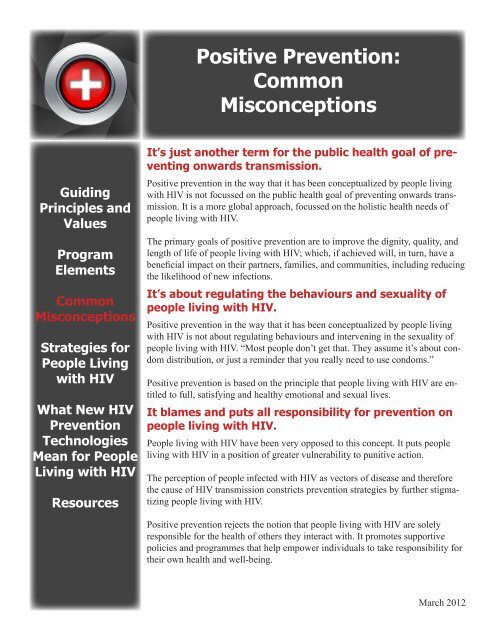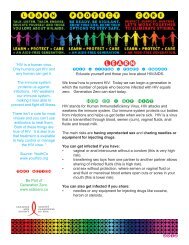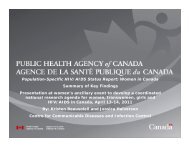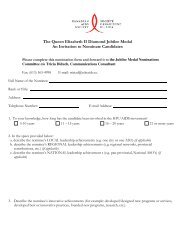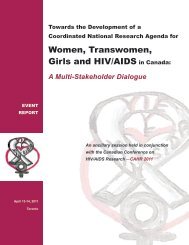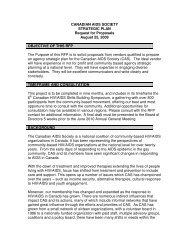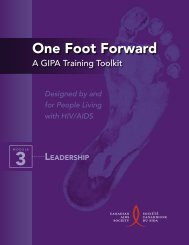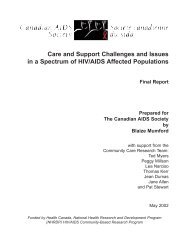Positive Prevention: Common Misconceptions
Positive Prevention: Common Misconceptions
Positive Prevention: Common Misconceptions
You also want an ePaper? Increase the reach of your titles
YUMPU automatically turns print PDFs into web optimized ePapers that Google loves.
<strong>Positive</strong> <strong>Prevention</strong>:<strong>Common</strong><strong>Misconceptions</strong>GuidingPrinciples andValuesProgramElements<strong>Common</strong><strong>Misconceptions</strong>Strategies forPeople Livingwith HIVWhat New HIV<strong>Prevention</strong>TechnologiesMean for PeopleLiving with HIVResourcesIt’s just another term for the public health goal of preventingonwards transmission.<strong>Positive</strong> prevention in the way that it has been conceptualized by people livingwith HIV is not focussed on the public health goal of preventing onwards transmission.It is a more global approach, focussed on the holistic health needs ofpeople living with HIV.The primary goals of positive prevention are to improve the dignity, quality, andlength of life of people living with HIV; which, if achieved will, in turn, have abeneficial impact on their partners, families, and communities, including reducingthe likelihood of new infections.It’s about regulating the behaviours and sexuality ofpeople living with HIV.<strong>Positive</strong> prevention in the way that it has been conceptualized by people livingwith HIV is not about regulating behaviours and intervening in the sexuality ofpeople living with HIV. “Most people don’t get that. They assume it’s about condomdistribution, or just a reminder that you really need to use condoms.”<strong>Positive</strong> prevention is based on the principle that people living with HIV are entitledto full, satisfying and healthy emotional and sexual lives.It blames and puts all responsibility for prevention onpeople living with HIV.People living with HIV have been very opposed to this concept. It puts peopleliving with HIV in a position of greater vulnerability to punitive action.The perception of people infected with HIV as vectors of disease and thereforethe cause of HIV transmission constricts prevention strategies by further stigmatizingpeople living with HIV.<strong>Positive</strong> prevention rejects the notion that people living with HIV are solelyresponsible for the health of others they interact with. It promotes supportivepolicies and programmes that help empower individuals to take responsibility fortheir own health and well-being.March 2012
It’s its own separate programming.<strong>Positive</strong> prevention is not separate from other programs,or a stand-alone initiative. This misconceptionmanifests itself as AIDS service organizationssaying that they need a positive prevention worker.There may still be a need for champions of positiveprevention, and people living with HIV articulatewhat positive prevention means.The components of positive prevention need to beintegrated into all programs responding to peopleliving with HIV. It is the establishment of a new culturalnorm in responding to people living with HIV.It should be integrated into anywhere people livingwith HIV can get programs.This can sometimes be challenging for organizationsthat have both support and prevention activities.There is often a different set of staff and volunteersworking on prevention and support, and they oftenwork with different populations: HIV-positive andHIV-negative.<strong>Positive</strong> prevention requires HIV service organisations,HIV support groups and NGOs to integratepositive prevention with existing HIV programmes.It is important that information and/or supportaround safer sex, re-infections, reproductive choices,the effects of ARV treatment, and safer injectingdrug use is available in all settings. This should includemedical centres, treatment delivery sites, familyplanning clinics, home-based care programmesand community centres.One approach will work for all.Not all people living with HIV are the same. To beeffective, programs must acknowledge the diversityof lived experiences amongst people living withHIV. They should that take into account the needsof people living with HIV who are of different genders,ethnicities, ages and sexual orientations.“Among those who are doing this work, we sometimesbelieve that positive prevention can work forall people living with HIV. I’m not so sure. Becausemost injection drug use and sexual practices aredriven by their respective cultures, these are verypowerful drivers—whether a programmatic responseto a system can be powerful enough to reacheverybody and make a shift in the culture is a bigquestion. There are some pretty strong drivers thatpeople use in their decision-making. Serosortingdidn’t come from prevention programming. Saferbarebacking didn’t come from prevention programs.Eros is ahead of our intellectual bravery.”


